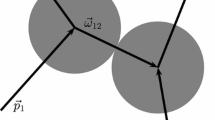Abstract
There is a relation between the irreversibility of thermodynamic processes as expressed by the breaking of time-reversal symmetry, and the entropy production in such processes. We explain on an elementary mathematical level the relations between entropy production, phase-space contraction and time-reversal starting from a deterministic dynamics. Both closed and open systems, in the transient and in the steady regime, are considered. The main result identifies under general conditions the statistical mechanical entropy production as the source term of time-reversal breaking in the path space measure for the evolution of reduced variables. This provides a general algorithm for computing the entropy production and to understand in a unified way a number of useful (in)equalities. We also discuss the Markov approximation. Important are a number of old theoretical ideas for connecting the microscopic dynamics with thermodynamic behavior.
Similar content being viewed by others
REFERENCES
C. Maes, Fluctuation theorem as a Gibbs property, J. Statist. Phys. 95:367-392 (1999).
C. Maes, F. Redig, and A. Van Moffaert, On the definition of entropy production via examples, J. Math. Phys. 41:1528-1554 (2000).
C. Maes, F. Redig, and M. Verschuere, From global to local fluctuation theorems, Moscow Mathematical Journal 1:421-438 (2001).
D. J. Evans, E. G. D. Cohen, and G. P. Morriss, Probability of second law violations in steady flows, Phys. Rev. Lett. 71:2401-2404 (1993).
G. Gallavotti and E. G. D. Cohen, Dynamical ensembles in nonequilibrium statistical mechanics, Phys. Rev. Letters 74: 2694-2697 (1995).Dynamical ensembles in stationary states, J. Statist. Phys. 80:931-970 (1995).
D. Ruelle, Smooth dynamics and new theoretical ideas in nonequilibrium statistical mechanics, J. Statist. Phys. 95:393-468 (1999).
L. Onsager and S. Machlup, Fluctuations and irreversible processes, Phys. Rev. 91:1505-1512 (1953). More generally Onsager–Machlup consider in their second paper (starting on page 1512) a second-order process for extensive variables (α, β)≡ (α1,..., αm; β1,..., βm) parametrizing the partition Γ that we had before. The difference between the α's and the β's arises from their different behavior under applying the time reversal Π; the β's are the so called “velocity” variables that change their sign if the time is reversed; the α's are even functions under time reversal. In all cases, they are thermodynamic variables that are sums of a large number of molecular variables.
R. Zwanzig, Memory effects in irreversible thermodynamics, Phys. Rev. 124:983-992 (1961). See also: S. Nakajima, Progr. Theoret. Phys. 20,948(1958); M. Mori, Progr. Theoret. Phys. 32,423(1965).
J. L. Lebowitz, Reduced description in nonequilibrium statistical mechanics, in Proceedings of International Conference on Nonlinear Dynamics, December 1979, Annals New York Academy of Sciences, Vol. 357 (1980), pp. 150-156.
Ya. G. Sinai, Introduction to Ergodic Theory (Princeton University Press, 1976).
C. Jarzynski, Nonequilibrium equality for free energy differences, Phys. Rev. Lett. 78:2690-2693 (1997).
J. Bricmont, Bayes, Boltzmann and Bohm: Probability in physics, in Chance in Physics, Foundations and Perspectives, J. Bricmont, D. Dürr, M. C. Galavotti, G. Ghirardi, F. Petruccione, and N. Zanghi, eds. (Springer-Verlag, 2002).
J. Schnakenberg, Network theory of behavior of master equation systems, Rev. Mod. Phys. 48, 571-585 (1976).
G. L. Eyink, J. L. Lebowitz, and H. Spohn, Microscopic origin of hydrodynamic behavior: Entropy production and the steady state, Chaos (Soviet-American Perspectives on Nonlinear Science), D. Campbell, ed. (1990), pp. 367-391.
M. Liu, The Onsager Symmetry Relation and the Time Inversion Invariance of the Entropy Production, Archive cond-mat/9806318.
E. T. Jaynes, The minimum entropy production principle, Ann. Rev. Phys. Chem. 31, 579-600 (1980).Papers on Probability, Statistics and Statistical Physics, R. D. Rosencrantz, eds.(Reidel, Dordrecht, 1983). Note however that historically, the Rayleigh principle (Lord Rayleigh, Phil Mag. 26:776 (1913)), was much closer to the variational principle in mechanics.
J. R. Dorfman, An Introduction to chaos in nonequilibrium statistical mechanics. (Cambridge University Press, Cambridge, 1999).
S. Sarman, D. J. Evans, and P. T. Cummings, Recent developments in non-Newtonian molecular dynamics, Physics Reports, Vol. 305, M. J. Klein, ed. (Elsevier, 1998), pp. 1-92.
There is the inconvenience that different thermostats may give rise to different rates of phase space contraction under the same macroscopic conditions so that one needs very specific thermostats to get the phase space contraction coincide with the physical entropy production. See C. Wagner, R. Klages and G. Nicolis, Thermostating by deterministic scattering: Heat and shear flow, Phys. Rev. E 60:1401-1411 (1999).
L. Andrey, The rate of entropy change in non-Hamiltonian systems, Phys. Lett. A 11:45-46 (1985).
S. Goldstein, Boltzmann's approach to statistical mechanics, in Chance in Physics, Foundations and Perspectives, J. Bricmont, D. Dürr, M. C. Galavotti, G. Ghirardi, F. Petruccione, and N. Zanghi, eds. (Springer-Verlag, 2002).
J. L. Lebowitz, Microscopic origins of irreversible macroscopic behavior, Phys. A 263, 516-527 (1999). Round Table on Irreversibility at STATPHYS20, Paris, July 22, 1998.
M. Kac, Probability and Related Topics in the Physical Sciences (Interscience Pub., New York, 1959).
E.T. Jaynes, Gibbs vs Boltzmann entropies, Amer. J. Phys. 33:391-398 (1965).R. D. Rosencrantz, ed., Papers on Probability, Statistics and Statistical Physics (Reidel, Dordrecht, 1983).
Author information
Authors and Affiliations
Corresponding author
Rights and permissions
About this article
Cite this article
Maes, C., Netočný, K. Time-Reversal and Entropy. Journal of Statistical Physics 110, 269–310 (2003). https://doi.org/10.1023/A:1021026930129
Issue Date:
DOI: https://doi.org/10.1023/A:1021026930129




